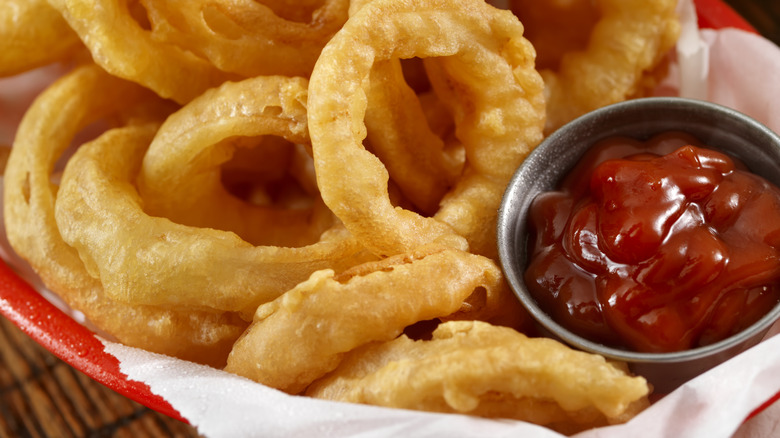The Origins Of Onion Rings Are More Contentious Than You'd Think
Ahhh, the humble onion ring. Whether enjoyed as a bar snack, a fast food side, or even a burger topping, onion rings are a classic bit of cuisine that is never an unwelcome arrival. You might not think to order them, but chances are, you will surely eat them if they're put in front of you.
With something this universal, you might think we'd know where they originally came from. You'd be wrong, though; onion rings' origin story is heavily disputed. Maybe it's unsurprising considering what a universal concept fried onions are; there's something about an onion that inexorably causes the human brain to think, "Aww heck yeah, imma fry that sucker;" it's why we have glorious creations like the bloomin' onion (and what is a bloomin' onion, if not an exploded plate of onion rings?). But perhaps more unexpected is that the stories can't even agree on which country is responsible for them.
Both England and America have cases for the creation of onion rings
The earliest reference anyone can find to something that resembles onion rings is from an 1802 British cookbook called "The Art of Cookery Made Easy and Refined." Though the recipe isn't explicitly called onion rings, the result looks pretty familiar: onions cut into round slices, battered in flour, cream, salt, pepper, and parmesan cheese, then boiled in lard. They were served with a mixture of melted butter and mustard, which seems a little weird, but hey, no judgment (besides, it's not like there's a signature onion ring condiment anyway).
That sounds like onion rings, but it's different enough that there's still a question — and strangely, there are no more references until the dawn of the 20th century. There, though, are a bunch: starting in 1902, dozens of recipes that either look like onion rings or are actually called onion rings began showing up in cookbooks (to be fair, the first battered and breaded one appears to be from 1914). But there's another place that claims to have invented them.
The self-proclaimed inventor of onion rings has a pretty dubious claim
Though pig stand restaurants no longer exist, they were all the rage in Texas for a while. Opening in 1921, Pig Stand was a chain started in Dallas by Jesse G. Kirby that seems to have been America's first drive-in restaurant. It was best known for the pig sandwich, similar to a pulled pork sandwich but topped with a sour relish instead of barbecue sauce. It also claimed to be the inventor of the onion ring. Perhaps Kirby thought he'd created the iconic side, but it seems clear from published recipes that predate the opening of the first Pig Stand that other people had definitely gotten there first.
It's really not clear what happened here, but this could very well be a case of convergent food evolution, whereby different people have similar ideas at different times without ever interacting directly with one another, or it could simply be a British recipe that made its way to America, evolving over time. Whoever is responsible, this much is for sure: We owe them a tremendously greasy debt of gratitude.


